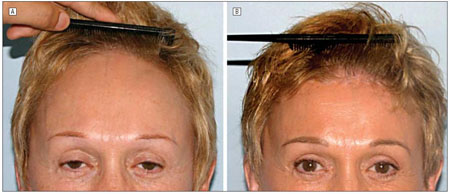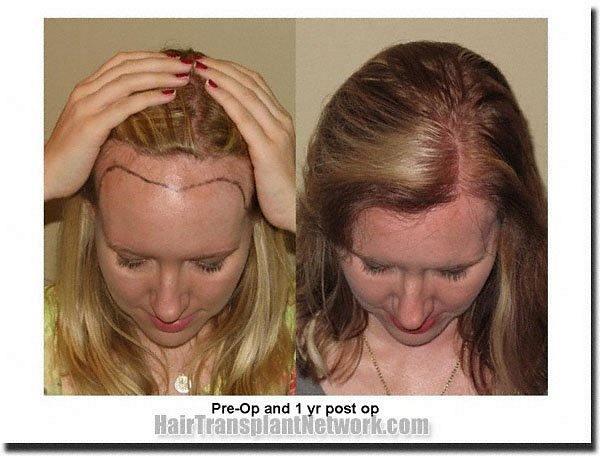The Ideal Female Hairline – Correcting the High Forehead
The female hairline is variable in position. However, a “normal” female hairline is typically positioned 5 to 6.5cm above the brows and usually begins at some point where the scalp slopes from a more horizontal position to a vertical one. This optimal position allows for ease of hairstyling and provides facial harmony and balance.
There are a number of women who have a hereditary high hairline (or high forehead). The appearance of a high hairline can make women look masculine and/or older than their years. The associated high forehead is often seen as unattractive and their hair styling is often limited to combing downward (bangs) to camouflage it. These women, even though there are no signs of hair loss, are dissatisfied with their naturally high forehead and wish they could lower their hairline to a more cosmetically pleasing location.
State of the art follicular unit hair transplantation can be an effective procedure to treat these patients and has a minimal risk of complications. However, this technique is labor intensive, time consuming, and can be expensive, especially since these patients often require multiple sessions to achieve the 2-4 cm of hairline lowering required with adequate hair density acceptable to women. In addition, these women may have to wait for 2-4 years for hair growth to see the full result after surgical hair replacement.
Below, we summarize how this low risk hairline lowering technique can produce outstanding results rapidly and is readily available and acceptable to female patients with high foreheads.
The Operation
The female hairline lowering procedure starts by making a non-repeating, irregular trichophytic incision within the fine hairs of the anterior hairline. This incision cuts across the hair shafts but leaves the bulb of the hair follicle intact. This trichophytic technique allows hair growth through the scar to help camouflage it. By these methods, we try to create a similar transition zone as seen in follicular unit grafting. The hairline subsequently appears natural and undetectable.
After the incision, the scalp lifted off of the skull all the way to the back of it. Tumescence is used to minimize bleeding. Extensive undermining (a process used to separate the scalp from the underlying muscles and supporting tissue to increase elasticity) is performed in this plane and is rapid and bloodless. In the forehead, dissection in this plane is done to just below where we want the hairline. The scalp is then advanced forward and the excess non-hair bearing forehead skin is excised with an incision that is parallel to the beveled trichophytic incision.
The wound is closed in two layers. The deep layer of the scalp is closed for strength and to approximate the wound edges. The skin closure is done with delicate fine stitches. To ensure a good cosmetic result, there is no tension on the wound. Other maneuvers such as incisions on the undersurface of the scalp and the placement of tack-like device (Endotine) are usually incorporated to get optimal results. A light dressing is placed and removed on the first post-operative day. A cosmetic result is appreciated immediately. The hair may be combed downward and there is minimal bruising and edema. Sutures are removed 4-7 days later. Many patients have resumed working and social actives in 2-5 days. Our out of town patients usually travel home one or two days after surgery.

Before and After the Procedure
There are two variations with this procedure that have proved useful. First, if the hairline needs to be advanced a large distance or if the scalp is tight, a tissue expander (a balloon-like device similar to an inflatable breast implant) may be required. This is done as a staged procedure, with placement of the expander as the first stage and advancement of the hairline as the second stage. Typically, the balloon is expanded over a 6-week period, e.g. 75-100 cc per week, to stretch the scalp sufficiently to allow for 4-6 cm of advancement. This is well tolerated by patients aside from the cosmetic inconvenience during the last three weeks of the expansion. Ten percent of patients seem to require this expansion process.
The second variation of this procedure is to combine the hairline advancement with a brow lift. For this procedure, the forehead dissection is extended below the orbital rims and the frown muscles may be cut or cauterized from their undersurface. Before the skin excision and closure , the brows are fixed at the desired level.
The most important concern to this technique for hairline advancement is the possibility of an obvious or unattractive scar. The technical points of the trichophytic incision are critical in avoiding this complication. As the hair grows and the wound matures, the scar will become virtually non-existent. Hair grafts could later be performed if the scar were visible. Overall, patients tolerate this procedure very well. Patients often report some decreased sensation of the frontal scalp, but this usually resolves by 6 months. Other complications have been extremely rare.
The cost effectiveness of this procedure is significant when we consider time for hair growth and the absolute number of hairs moved. The average case of a 15 cm hairline moved down 2.5cm relocates over 3000 follicular units or over 7000 hairs.
To see how this procedure is performed, view the female hairline lowering procedure video demonstration.

















